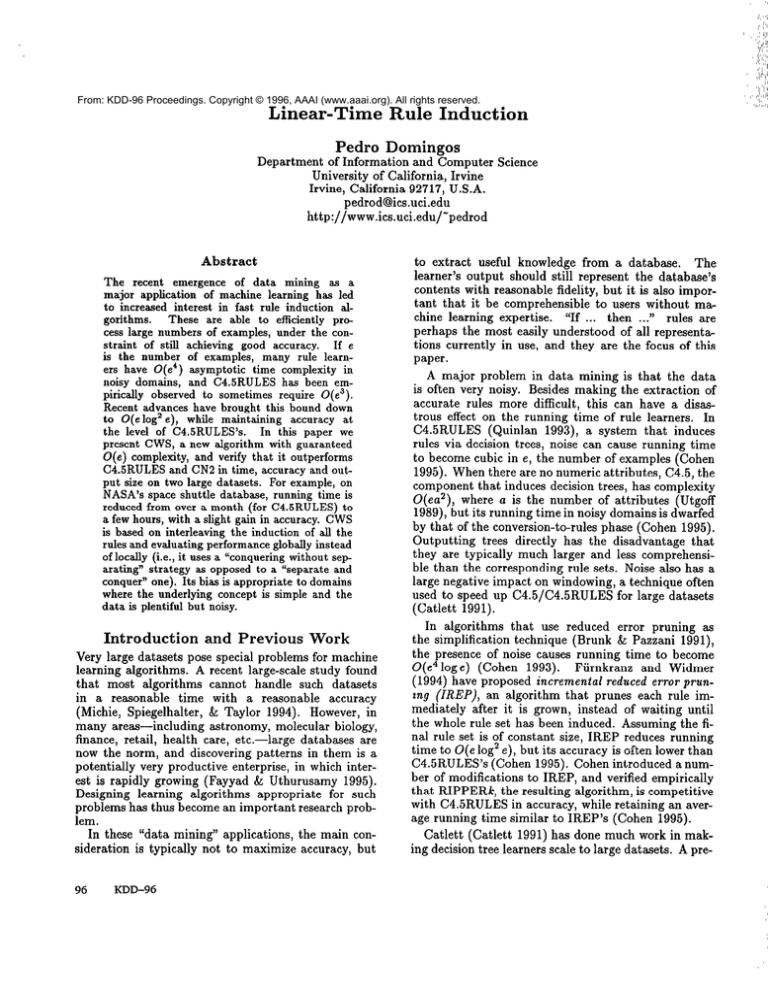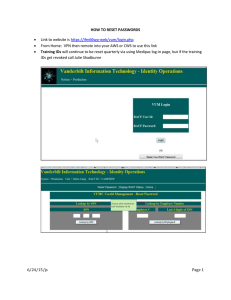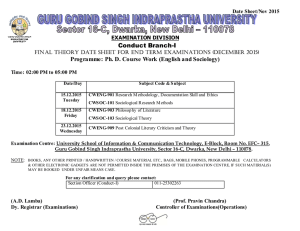
From: KDD-96 Proceedings. Copyright © 1996, AAAI (www.aaai.org). All rights reserved.
Linear-Time
Pedro
Rule Induction
Domingos
Department of Information and Computer Science
University of California, Irvine
Irvine, California 92717, U.S.A.
pedrod@ics.uci.edu
http:j/www.ics.uci.edu/“pedrod
Abstract
The recent emergence of data mining as a
major application of machine learning has led
to increased interest in fast rule induction algorithms.
These are able to efficiently process large numbers of examples, under the constraint of still achieving good accuracy. If e
is the number of examples, many rule learners have O(e4) asymptotic time complexity in
--T--. u”Inaln8,
J---:--->
Pl-lTTTlTclL-~~~~
uo,sy
ana rl.
u4.onu~fia
nit.7 I.-.neen empirically observed to sometimes require O(e3).
Recent advances have brought this bound down
to O(elog2 e), while maintaining
accuracy at
the level of C4.5RULES’s.
In this paper we
present CWS, a new algorithm with guaranteed
O(e) complexity, and verify that it outperforms
C4.5RULES and CN2 in time, accuracy and output size on two large datasets. For example, on
NASA’s space shuttle database, running time is
reduced from over a month (for C4.5RULES) to
a few hours, with a slight gain in accuracy. CWS
is based on interleaving the induction of all the
rules and evaluating performance globally instead
of locally (i.e., it uses a “conquering
without
sep-
arating* strategy as opposed to a “separate and
conquer,, one). Its bias is appropriate to domains
where the underlying concept is simple and the
data is plentiful but noisy.
Introduction
and Previous
Work
Very large datasets pose special problems for machine
learning algorithms. A recent large-scale study found
that most algorithms cannot handle such datasets
1::
a
‘X.P..M,W7~hl
cxw"IIcw&
time
with
&
reaonable
~Inl~"-n.*
cbLLUla,LJ
(Michie, Spiegelhalter, & Taylor 1994). However, in
many areas-including
astronomy, molecular biology,
finance, retail, health care, etc.-large
databases are
now the norm, and discovering patterns in them is a
potentially very productive enterprise, in which interest is rapidly growing (Fayyad & Uthurusamy 1995).
Designing learning algorithms appropriate for such
problems has thus become an important research problem.
In these “data mining” applications, the main consideration is typically not to maximize accuracy, but
96
KDD-96
to extract useful knowledge from a database. The
learner’s output should still represent the database’s
contents with reasonable fidelity, but it is also important that it be comprehensible to users without machine learning expertise. “If . . . then . ..” rules are
perhaps the most easily understood of all representations currently in use, and they are the focus of this
paper.
A major problem in data mining is that the data
is often very noisy. Besides making the extraction of
accurate rules more difficult, this can have a disastrous effect on the running time of rule learners. In
C4.5RULES (Q um
’ 1an 1993)) a system that induces
rules via decision trees, noise can cause running time
to become cubic in e, the number of examples (Cohen
1995). When there are no numeric attributes, C4.5, the
component that induces decision trees, has complexity
O(ea2), where a is the number of attributes (Utgoff
1989)) but its running time in noisy domains is dwarfed
by that of the conversion-to-rules phase (Cohen 1995).
.I:-..-&,.. us
L-- LL21--J --_I I--. 11.-L
rL.C-..AC:-- cb~-ccs
_^^^ ummy
VUL~ULLIII~
me u~sauvamage
ma6
they are typically much larger and less comprehensible than the corresponding rule sets. Noise also has a
large negative impact on windowing, a technique often
used to speed up C4.5/C4.5RULES for large datasets
(Catlett 1991).
In algorithms that use reduced error pruning as
the simplification technique (Brunk & Pazzani 1991))
the presence of noise causes running time to become
O(e4 loge) (Cohen 1993). Fiirnkranz and Widmer
(1994) have proposed incremental reduced error prunZRO
/IREP).,, an
~ !~~.~~
~-- alsorithm
--9---.----- that nruneq
=- -___L each ru!e immediately after it is grown, instead of waiting until
the whole rule set has been induced. Assuming the final rule set is of constant size, IREP reduces running
time to O(e log2 e), but its accuracy is often lower than
C4.5RULES’s (Cohen 1995). Cohen introduced a number of modifications to IREP, and verified empirically
that RIPPERk,
the resulting
algorithm,
is competitive
with C4.5RULES in accuracy, while retaining an average running time similar to IREP’s (Cohen 1995).
Catlett (Catlett 1991) has done much work in making decision tree learners scale to large datasets. A pre-
liminary empirical study of his peepholing technique
shows that it greatly reduces C4.5’~ running time without significantly affecting its accuracy.l To the best of
our knowledge, peepholing has not been evaluated on
any large real-world datasets, and has not been applied
to rule learners.
A number of algorithms achieve running time linear in e by forgoing the greedy search method used by
the learners above, in favor of exhaustive or pruned
near-exhaustive search (e.g., (Weiss, Galen, & Tadepalli 1987; Smyth, Goodman, & Higgins 1990; Segal
P. zu,:-.:
(YI
Lrbiil”1U
Anne\\
l.TJ-a,,.
l.r ^___^._^_ Al.:- ^^ .__^^ -..--:-I1”wczYe3z) blllS C~llSCJ rurllll‘lg
A:-blIIK
to become exponential in a, leading to a very high
cost per example, and making application of those algorithms to large databases difficult.
Holte’s 1R algorithm (Holte 1993) outputs a single tree node, and
is linear in a and O(eloge), but its accuracy is often
much lower than C4.5’~.
Ideally, we would like to have an algorithm capable
of inducing accurate rules in time linear in e, without
becoming too expensive in other factors. This paper
describes such an algorithm and its empirical evalua
tion. The algorithm is presented in the next section,
which also derives its worst-case time complexity. A
comprehensive empirical evaluation of the algorithm is
then reported and discussed.
The CWS Algorithm
Most rule induction algorithms employ a “separate and
method, inducing each rule to its full length
before going on to the next one. They also evaluate
each rule by itself, without regard to the effect of other
rules. This is a potentially inefficient approach: rules
may be grown further than they need to be, only to
be pruned back afterwards, when the whole rule set
has already been induced. An alternative is to interleave the construction of all rules, evaluating each rule
in the context of the current rule set. This can be
termed a “conquering without separating” approach,
by contrast with the earlier method, and has been implemented in the CWS algorithm.
In CWS, each example is a vector of attrebute-value
pairs, together with a specification of the class to which
it belongs; attributes can be either nominal (symbolic)
or numem. Each rule consists of a conjunction of antecedents (the body) and a predicted class (the head).
Each antecedent is a condition on a single attribute.
Conditions on nominal attributes are equality tests of
the form ai = vij, where ai is the attribute and vij
is one of its legal values. Conditions on numeric attributes are inequalities of the form ai > vij or ai < vii.
Each rule in CWS is also associated with a vector of
class probabilities computed from the examples it covconquer”
‘Due to the small number of data points (3) reported
for the single real-world domain used, it is difficult to determine the exact form of the resulting time growth (linear,
log-linear, etc.).
Table 1: The CWS algorithm.
Procedure CWS
Let RS = 0.
Repeat
Add one active rule with empty body to RS.
For each active rule R in RS,
For each possible antecedent AV,
Let R’ = R with AV conjoined to its body.
o..--..A-l--- ---LA anu
--J ---J
-I--- I-- n,
U"lqJUb~
CIsLs;S yruvs.
yrau.
class 1or n.
Let RS’ = RS with R replaced by R’.
If Acc(RS’) > Acc(RS) then let RS = RS’.
If RS is unchanged then deactivate R.
Until all rules are inactive.
Return RS.
ers; the predicted class is the one with the highest probability. For class C,, P,.(Ci) is estimated by n,i/n,,
where n, is the total number of examples covered by
rule T, and n,i is the number of examples of the ith
class among them. When a test example is covered by
more than one rule, the class probability vectors of all
the rules covering it are summed, and the class with the
highest sum is chosen as the winner. This is similar to
the approach followed in CN2 (Clark & Boswell 1991))
with the difference that probabilities are used instead
of frequencies. In a system like CN2, this could give
undue weight to rules covering very few examples (the
“small disjuncts” (Holte, Acker, & Porter 1989)), but
we have verified empirically that in CWS this problem
is largely avoided. Examples not covered by any rules
are assigned to the class with the most examples in the
training set.
CWS is outlined in pseudo-code in Table 1. Initially
the rule set is empty, and all examples are assigned
to the majority class. In each cycle a new rule with
empty body is tentatively added to the set, and each
of the rules already there is specialized by one additional antecedent. Thus induction of the second rule
starts immediately after the first one is begun, etc.,
and induction of all rules proceeds in step. At the end
of each cycle, if a rule has not been specialized, it is
deactivated, meaning that no further specialization of
it will be attempted. If the rule with empty body is
deactivated, it is also deleted from the rule set. A rule
with empty body predicts the default class, but this
is irrelevant, because a rule only starts to take part
in the classification of examples once it has at least
one antecedent, and it will then predict the class that
most training examples satisfying that antecedent belong to. A rule’s predicted class may change as more
antecedents are added to it. Acc(RS) is the accuracy
of the rule set RS on the training set (i.e., the fraction of examples that RS classifies correctly). Most
rule induction algorithms evaluate only the accuracy
Decision-Tree br Rule Induction
97
(or entropy, etc.) of the changed rule on the examples
that it still covers. This ignores the effect of any other
rules that cover those examples, and also the effect of
uncovering some examples by specializing the rule, and
leads to a tendency for overspecialization that has to
be countered by pruning. CWS avoids this through
its global evaluation procedure and interleaved rule induction.
Let e be the number of examples, a the number
of attributes, ZI the average number of values per attribute, c the number of classes, and T the number of
rules produced. The basic step of the algorithm involves adding an antecedent to a rule and recomputing Acc(RS’). This requires matching all rules with
all training examples, and for each example summing
the class probabilities of the rules covering it, implying a time cost of O[re(a + c)]. Since there are O(av)
possible antecedents, the cost of the inner loop (“For
each AV”, see Table 1) is O[avre(a + c)], However,
this cost can be much reduced by avoiding the extensive redundancy present in the repeated computation
of Acc(RS’). The key to this optimization is to avoid
rematching all the rules that remain unchanged when
attempting to specialize a given rule, and to match the
unchanged antecedents of this rule with each example
only once. Recomputing Acc(RS’) when a new antecedent AV is attempted now involves only checking
whether each example already covered by the rule also
satisfies that antecedent, at a cost of O(e), and updating its class probabilities if it does, at a cost of O(ec).
The latter term dominates, and the cost of recomputing the accuracy is thus reduced to O(ec), leading to a
cost of O(eavc) for the “For each AV” loop.
In more detail, the optimized procedure is as follows. Let Cprobs(R) d enote the vector of class probabilities for rule R, and Cscores(E) denote the sum
of the class probability vectors for all rules covering
example E. Cscores(E) is maintained for each example throughout. Let R be the rule whose specialization
is going to be attempted. Before the “For each AV”
loop begins, R is matched to all examples and those
which satisfy it are selected, and, for each such example E, Cprobs(R) is subtracted from Cscores( E).
Cscores(E) now reflects the net effect of all other rules
on the example. Each possible antecedent AV is now
conjoined to the rule in turn, leading to a changed rule
R’ (or R’(AV), to highlight that it is a function of AV).
New class probabilities for R’ are computed by fmding which examples E’ among the previously-selected
ones satisfy AV. These probabilities are now added
to Cscores(E’) for the still-covered examples E’. Examples that were uncovered by the specialization already have the correct values of Cscores(E), since the
original rule’s Cprobs(R) were subtracted from them
beforehand, All that remains is to find the new winning class for each example E. If the example was
previously misclassified and is now correctly classified,
there is a change of +1/e in the accuracy of the rule
98
KDD-96
Table 2: The optimized CWS algorithm.
Procedure CWS
Let RS = 0.
Let Cscores(E) = 0 for all E, C.
Repeat
Add one active rule R, with empty body to RS.
Let Cprobs(R,) = 0 for all C.
For each active rule R in RS,
For each example E covered by R,
Subtract Cprobs(R) from Cscores(E).
For each possible antecedent AV,
Let AAcc(AV) = 0.
Let R’ = R with AV conjoined to it.
Compute Cprobs(R’) and its pred. class.
For each example E’ covered by R’
Add Cprobs( R’) to Cscores( E’).
For each example E covered by R
Assign E to class with max. Cscore(E).
Compute AAccE(AV) (-l/e, 0 or +1/e).
Add AAccE(AV) to AAcc(AV).
Pick AV with max. AAcc(AV).
If AAcc(AV) > 0 then R = R’(AV),
eise deactivate iz.
For each ex. E covered by R (R = R’ or not)
Add Cprobs(R) to Cscores(E).
Until all rules are inactive.
Return RS.
set. If it was previously correctly classified, the change
is -l/e.
Otherwise there is no change. Summing this
for all the examples yields the global change in accuracy. As successive antecedents are attempted, the
best antecedent and maximum global change in accuracy are remembered. At the end of the loop the best
antecedent is permanently added to the rule, if the corresponding change in accuracy is positive. This simply
involves repeating the procedure above, this time with
permanent effects. If no antecedent produces a positive
change in accuracy, the rule’s original class probabilities Cprobs(R) are simply re-added to the Cscores(E)
of all the examples that it covers, leaving everything
as before. This procedure is shown in pseudo-code in
Table 2. Note that the optimized version produces exactly the same output as the non-optimized one; conceptually, the much simpler Table 1 is an exact description of the CWS algorithm.
The total asymptotic time complexity of the algorithm is obtained by multiplying O(eavc) by the maximum number of times that the double outer loop (“Repeat . . . For each R in RS . . .“) can run. Let s be
the output size, measured as the total number of antecedents effectively added to the rule set. Then the
double outer loop runs at most O(s), since each computation within it (the “For each AV” loop) adds at
most one antecedent. Thus the total asymptotic time
complexity of CWS is O(eavcs).
The factor s is also present in the complexity of
other rule induction algorithms (CN2, IREP, RIPPERE, etc.), where it can typically grow to O(eu). It
can become a significant problem if the dataset is noisy.
However, in CWS it cannot grow beyond O(e), because
each computation within the double outer loop (“Repeat . . . For . . . “) either produces an improvement in
accuracy or is the last one for that rule, and in a dataset
with e examples at most e improvements in accuracy
CAJIannn&hla
CuIb
y”UUI”Ic..
TAP~llW
~U.Au&J,
nhr\,.lrl
uo Ull”UlU
he
“C ;nAananrlc.nt
I‘IULI~~llUlrll”
le+O6
nn.4
“IA.FPc, cu,lU
this is the assumption made in (Fiirnkranz & Widmer
1994) and (Cohen 1995), and verified below for CWS.
CWS incorporates three methods for handling numeric values, selectable by the user. The default
method discretizes each attribute into equal-sized intervals, and has no effect on the asymptotic time complexity of the algorithm.
Discretization can also be
performed using a method similar to Catlett’s (Catlett
1991)) repeatedly choosing the partition that minimizes entropy until one of several termination conditions is met. This causes learning time to become
O(eloge), but may improve accuracy in some situ&
tions. Finally, numeric attributes can be handled directly by testing a condition of each type (ui > vij
and ui < vii) at each value vii. This does not change
the asymptotic time compiexity, but may cause v to
become very large. Each of the last two methods may
improve accuracy in some situations, at the cost of
additional running time. However, uniform discretization is surprisingly robust (see (Dougherty, Kohavi, &
Sahami 1995))) and can result in higher accuracy by
helping to avoid overfitting.
Missing values are treated by letting them match
any condition on the respective attribute, during both
learning and classification.
Empirical
le+O7
Evaluation
This section describes an empirical study comparing
CWS with C4.5RULES and CN2 along three variables:
running time, accuracy, and comprehensibility of the
output. All running times were obtained on a Sun 670
computer. Output size was taken as a rough measure
of comprehensibility, counting one unit for each antecedent and consequent in each rule (including the default rule, with 0 antecedents and 1 consequent). This
measure is imperfect for two reasons. First, for each
system the meaning of a rule is not necessarily transparent: in CWS and CN2 overlapping rules are probabilistically combined to yield a class prediction, and
n” CnrTrcIo tmcu
---I- .rut:. ..I-.-s itubtm2utmc
^-L^-^I^-C sjlut:
LJ- 15:
:- z--1:iii vk.ilnm~1~m
uuyucitly conjoined with the negation of the antecedents of
all preceding rules of different classes. Second, output
simplicity is not the only factor in comprehensibility,
which is ultimately subjective. However, it is an acceptable and frequently used approximation, especially
when the systems being compared have similar output,
1CUOO
1000
1OOOOO
No. examples
Figure 1: Learning times for the concept ubc V def.
as here (see (Catlett 1991) for further discussion).
A preliminary
study was conducted using the
Boolean concept abc V de f as the learning target, with
each disjunct having a probability of appearing in the
data of 0.25, with 13 irrelevant attributes, and with
20% class noise (i.e., each class label has a probability
of 0.2 of being flipped). Figure 1 shows the evolution
of learning time with the number of examples for CWS
and C4.5RULES, on a log-iog scaie. Recaii that on this
type of scale the slope of a straight line corresponds to
the exponent of the function being plotted. Canonical
functions approximating each curve are also shown, as
well as e log e, the running time observed by Cohen
(Cohen 1995) for RIPPERk and IREP.’ CWS’s running time grows linearly with the number of examples,
as expected, while C4.5RULES’s is O(e2 loge). CWS is
also much faster than IREP and RIPPERlc (note that,
even though the log-log plot shown does not make this
evident, the difference between e and elog2 e is much
larger than e).
CWS is also more accurate than C4.5RULES for
each number of examples, converging to within 0.6%
of the Bayes optimum (80%) for only 500 examples,
and reaching it with 2500, while C4.5RULES never
rises above 75%. CWS’s output size stabilizes at 9,
while C4.5RULES’s increases from 17 for 100 examples to over 2300 for 10000. Without noise, both sy5
terns learn the concept easily. Thus these results indicate that CWS is more robust with respect to noise, at
least in this simple domain. CN2’s behavior is similar
to C4.5RULES’s in time and accuracy, but it produces
larger rule sets.
The relationship between the theoretical bound of
O(eavcsj and CWS’s actual average running time was
investigated by running the system on 28 datasets from
the UC1 repository3 (Murphy & Aha 1995). Figure 2
‘The constants a, b and c were chosen so as to make the
respective curves fit conveniently in the graph.
3Audiology, annealing, breast cancer (Ljubljana), credit
Decision-Tree Q Rule Induction
99
le+O7
le+O6
.
0.11
loooo
looooo
Figure 2: Relationship
learning times.
1PA-K
.-l-Y
eaves
id-h7
. ..I".
of empirical
and theoretical
plots CPU time against the product euvcs. Linear regression yields the line time = 1.1 x lo5 eaves + 5.1,
with a correlation of 0.93 (R2 = 0.87). Thus eaves explains almost all the observed variation in CPU time,
confirming the prediction of a linear bound.4
Experiments were also conducted on NASA’s space
shuttle database. This database contains 43500 training examples from one shuttle flight, and 14500 testing
examples from a different flight. Each example is described by nine numeric attributes obtained from sensor readings, and there are seven possible classes, corresponding to states of the shuttle’s radiators (Catlett
1991). The goal is to predict these states with very
high accuracy (99-99.9%), using rules that can be
taught to a human operator. The data is known to be
relatively noise-free; since our interest is in induction
algorithms for large noisy databases, 20% class noise
.x,n~
I”cA.3
nrlr-lwl
UUUbU
ffi
U”
the
U.Ib
tvn;n;nrr
UlUllllllcj
s4.st-s
uuvu
fnlln.xr;nm
I”llV.1111~
n n~~awl..~~
(1,
yl”L.wAuzr;
similar to Catlett’s (each class has a 20% probability
of being changed to a random class, including itself).
The evolution of learning time with the number of
training examples for CWS and C4.5RULES is shown
in Figure 3 on a log-log scale, with approximate asympCWS’s curve is aptotes also shown, as before.
proximately log-linear, with the logarithmic
factor attributable to the direct treatment of numeric values
that
was employed.
(Uniform
discretization
resulted
in linear time, but did not yield the requisite very high
accuracies.) C4.5RULES’s curve is roughly cubic. Exscreening (Australian),
chess endgames (kr-vs-kp), Pima
diabetes, echocardiogram, glass, heart disease (Cleveland),
hepatitis, horse colic, hypothyroid, iris, labor negotiations,
lung cancer, liver disease, lymphography, mushroom, postoperative, promoters, primary tumor, solar flare, sonar,
soybean (small), splice junctions, voting records, wine, and
zoology.
4Also, there is no correlation between the number of
examples e and the output size .s (R2 = 0.0004).
100
KDD-96
loo
1rrllQ
A",""
loo0
!oooo
No. examples
1ooooO
Figure 3: Learning times for the shuttle database.
trapolating from it, C4.5RULES’s learning time for the
full database would be well over a month, while CWS
takes 11 hours.
Learning curves are shown in Figure 4. CWS’s accuracy is higher than C4.5RULES’s for most points,
and generally increases with the number of examples,
showing that there is gain in using the larger samples,
up to the full dataset.
Figure
5 shows theevolutidn
of
output size. CWS’s is low and almost constant, while
C4.5RULES’s grows to more than 500 by e = 32000.
Up to 8000 examples, CN2’s running time is similar
to C4.5RULES’s, but its output size grows to over
1700, and its accuracy never rises above 94%.5 In summary, in this domain CWS outperforms C4.5RULES
and CN2 in running time, accuracy and output size.
Compared to the noise-free case, the degradation in
CWS’s accuracy is less than 0.2% after e = 100, the
rule set size is similar, and learning time is only deburnrl~rl
Awy.,u
hv
“J
ua rnnetanf
“V..Y”UUY
fartnr
lY”““I
lnf
\“A
u9 fswr
I”..
nncennt
yu’
uu”“,
nn
“11
9-ruv-
erage). Thus CWS is again verified to be quite robust
with respect to noise.
Conclusions
and Future
Work
This paper introduced CWS, a rule induction algorithm that employs a “conquering without separating”
strategy instead of the more common “separate-andconquer” one. CWS interleaves the induction of all
rules and evaluates proposed induction steps globally.
Its asymptotic time complexity is linear in the number of examples. Empirical study shows that it can
be used to advantage when the underlying concept is
simple and the data is plentiful but noisy.
Directions for future work include exploring ways of
boosting CWS’s accuracy (or, conversely, broadening
the set of concepts it can learn effectively) without affecting its asymptotic time complexity, and applying it
to larger databases and problems in different areas.
5For e > 8000 the program crashed due to lack of memory. This may be due to other jobs running concurrently.
cws c4.5R -+--
-
No. examples
Figure 4: Learning curves for the shuttle database.
1
,
loo0
1OOOO
No. examples
1OOOOO
Figure 5: Output size growth for the shuttle database.
Acknowledgments
This work was partly supported by a JNICT/PRAXIS
XXI scholarship. The author is grateful to Dennis Kibler for many helpful comments and suggestions, and
to all those who provided the datasets used in the empirical study.
References
Brunk, C., and Pazzani, M. J. 1991. An investiga,
tion of noise-tolerant relational concept learning algorithms. In Proceedings of the Eighth International
Workshop on Machine Learning, 389-393. Evanston,
IL: Morgan Kaufmann.
Catlett, J. 1991. Megaznductzon: Machine Learning
on Very Large Databases. Ph.D. Dissertation, Basser
Department of Computer Science, University of Sydney, Sydney, Australia.
Clark, P., and Boswell, R. 1991. Rule induction
with CN2: Some recent improvements. In Proceedings
of the Sixth European Working Session on Learning,
151-163. Porto, Portugal: Springer-Verlag.
Cohen, W. W. 1993. Efficient pruning methods for
separate-and-conquer rule learning systems. In Proceedings of the Thirteenth International Joint Conference on Artificial Intelligence, 988-994. Chambery,
France: Morgan Kaufmann.
Cohen, W. W. 1995. Fast effective rule induction.
In Proceedings of the Twelfth International
Conference on Machine Learning, 115-123. Tahoe City, CA:
Morgan Kaufmann.
Dougherty, J.; Kohavi, R.; and Sahami, M. 1995.
Supervised and unsupervised discretization of continuous features. In Proceedings of the Twelfth International Conference on Machine Learning, 194-202.
Tahoe City, CA: Morgan Kaufmann.
Fayyad, U. M., and Uthurusamy, R., eds. 1995.
Proceedings of the First International Conference on
Knowledge Discovery and Data Mining,
Montreal,
Canada: AAAI Press.
Fiirnkranz, J., and Widmer, G. 1994. Incremental
reduced error pruning. In Proceedings of the Eleventh
International Conference on Machine Learning, 7077. New Brunswick, NJ: Morgan Kaufmann.
Holte, R. C.; Acker, L. E.; and Porter, B. W. 1989.
Concept learning and the problem of small disjuncts.
In Proceedings of the Eleventh International
Joint
Conference on Artificial Intelligence, 813-818. Detroit, MI: Morgan Kaufmann.
Holte, R. C. 1993. Very simple classification rules perform well on most commonly used datasets. Machine
Learning 11:63-91.
Michie, D.; Spiegelhalter, D. J.; and Taylor, C. C.,
eds. 1994. Machine Learning, Neural and Statistical
Classification. New York: Ellis Horwood.
Murphy, P. M., and Aha, D. W.
1995. UC1
repository of machine learning databases. Machinereadable data repository, Department of Information
and Computer Science, University of California at
Irvine, Irvine, CA.
Quinlan, J. R. 1993. Cd.5: Programs for Machine
Learning. San Mateo, CA: Morgan Kaufmann.
Segal, R., and Etzioni, 0. 1994. Learning decision lists using homogeneous rules. In Proceedings
of the Twelfth National Conference on Artificial Intelligence, 619-625. Seattle, WA: AAAI Press.
Smyth, P.; Goodman, R. M.; and Higgins, C. 1990.
A hybrid rule-based/Bayesian classifier. In Proceedings of the Nznth European Conference on Artificial
Intelligence, 610-615. Stockholm, Sweden: Pitman.
Utgoff, P. E. 1989. Incremental induction of decision
trees. Machine Learnzng 4:161-186.
Weiss, S. M.; Galen, R. M.; and Tadepalli, P. V. 1987.
Optimizing the predictive value of diagnostic decision
rules. In Proceedings of the Sixth National Conference on Artificial Intelligence, 521-526. Seattle, WA:
AAAI Press.
Decision-Tree 6-cRule Induction
101





